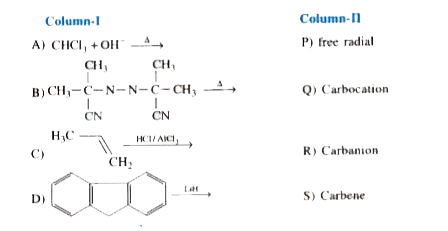Assertion (A): Methane can't act as Lewis acid
Reason (R): The carbon can't expand it's octet by accepting electron pairs. Solution in Telugu
Both A and R are true
Both A and R are false
Both A and R are true but R is not correct explanation of A
Both A and R are true and R is correct explanation of A
The correct Answer is:D
Step by step video, text & image solution for Assertion (A): Methane can't act as Lewis acid Reason (R): The carbon can't expand it's octet by accepting electron pairs. by Chemistry experts to help you in doubts & scoring excellent marks in Class 11 exams.
Updated on:21/07/2023Topper's Solved these Questions
- HYDROGEN AND ITS COMPOUNDSBook:AAKASH SERIESChapter:HYDROGEN AND ITS COMPOUNDSExercise:OBJECTIVE EXERCISE - 3
Explore 48 Videos
- HYDROGEN AND ITS COMPOUNDSBook:AAKASH SERIESChapter:HYDROGEN AND ITS COMPOUNDSExercise:EXERCISE ON PASSAGE
Explore 14 Videos
- HYDROGEN AND ITS COMPOUNDSBook:AAKASH SERIESChapter:HYDROGEN AND ITS COMPOUNDSExercise:OBJECTIVE EXERCISE - 2A (HYDROGEN PEROXIDE)
Explore 31 Videos
- HYDROCARBONSBook:AAKASH SERIESChapter:HYDROCARBONSExercise:ADDITIONAL PRACTICE SHEET ( LEVEL-II (PRACTICE SHEET (ADVANCED) (MATRIX MATCHING TYPE QUESTIONS)))
Explore 5 Videos
- IONIC EQUILIBRIUM Book:AAKASH SERIESChapter:IONIC EQUILIBRIUM Exercise:ADDITIONAL PRACTICE EXERCISE (LEVEL -II PRACTICE SHEET (ADVANCED) (Integer Type Questions))
Explore 8 Videos
Similar Questions
Bond length in H2 molecule is 'x' nm. The covalent radius of deuterium is
View SolutionRead the following passage and answer the questions that follow.
Electron-precise compounds have the required number of electrons to write their conventional Lewis structures. All elements of group 14 form such compounds which are tetrahedral in geometry. Electron - rich hydrides have excess of electrons which are present as lone pairs. Elements of groups 15-17 form such compounds. Metallic hydrides are formed by many d-block and f-block elements. These hydrides conduct heat and electricity though not as efficiently as their parent metals do. They are non-stoichiometric.
Electron precise compound among the following is
View SolutionIn electrolysis of dilute H2SO4, what is liberated at anode in the presence of inert electrode ?
View SolutionMatch the intermediates formed in the reaction.

View SolutionA certain weak acid has Ka,=10−5. If the equilibrium constant for is its reaction with a strong base is repesented as y×10y then find the value of y.
View SolutionAssertion (A) : CCl_4 is inert towares hydrolusis but SiCl_4 is readily hyrolyde . Reason (R) : Carbon cannot expland its octet but silicon can expand its cotet .
View SolutionAssertion : Direction of current can't be from negative potential
Reason : Direction of current is opposite to flow of electrons.
View SolutionSulphur dioxide can't act as a/an
View Solutionकार्बन टेट्राक्लोराइड से होकर विद्युत-धरा क्यों नहीं प्रवाहित की जा सकती हैं ?
View SolutionAn element M forms three types of compounds with fluorine : Compound (i) polar with complete octet Compound (ii) polar with expanded octet Compound (iii) non-polar with expanded octet then element 'M' can't be :
View SolutionAssertion : In the reaction , I2+I−→I3,I2 acts as a Lewis base.
Reason : In this reaction I2 donates a electron pair to I−.
View SolutionAssertion : BF3 is a Lewis acid.
Reason : It accepts a pair of electrons due to the presence of vacant orbital in the valence shell of boron.
View SolutionAssertion : CO_2 is a Lewis Acid. Reason: It can accept a proton.
View SolutionWhy can't aluminium be reduced by carbon ?
View SolutionAny species capable of accepting a lone pair of electrons acts as a lewis acid, where as a species capable of donating a proton acts as a Bronstead acid.
Which of the following is not a lewis acid ?
View Solution

